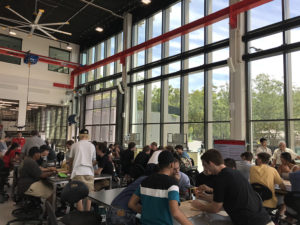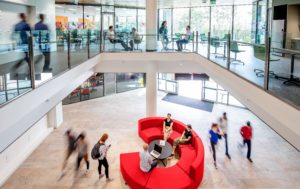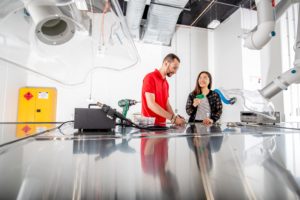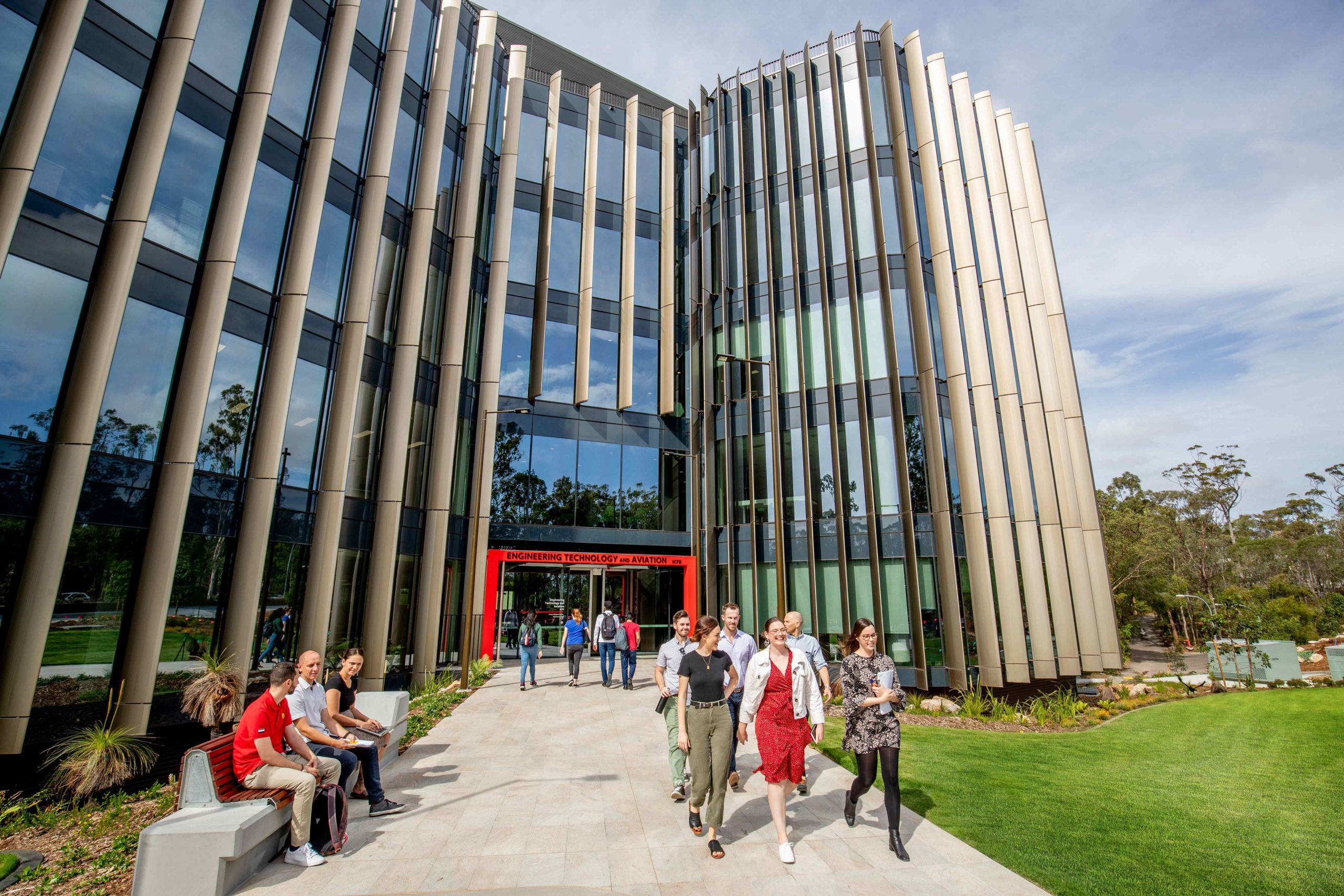Griffith Engineering students have been the first to ‘play’ in a stunning 10m high laboratory space within the university’s newest academic building at Nathan campus.

The high bay lab, as it’s known, includes an indoor drone fly-zone and a gantry upon which a lightweight aircraft or vehicle can be suspended so that students can practice remote inspections, using the latest technology to test solutions to tricky problems in a unique learning space.
The new Engineering, Technology and Aviation Building (N79) features 6,000m2 and six levels of adaptable, multi-functional and innovative spaces which offer students enhanced opportunities with the latest technology.

From concept to reality took three years, the landmark project led by Associate Professor Cheryl Desha, a Bachelor of Environmental Engineering graduate from Griffith who returned to her alma mater to spearhead the ambitious project alongside Griffith Sciences colleague Stephen Boyd.
“We were determined to create a building that students love to be in, which was elegant, functional and future flexible for evolving teaching and learning needs,” said Associate Professor Desha, now the Engagement Director (Industry) for the School of Engineering and Built Environment.
“This is an energy efficient, low carbon building that includes specialised laboratories, workshops, informal learning spaces, engagement spaces, a simulation studio and a rooftop garden that students can access.”
“The whole building is also considered a ‘Living Laboratory’ where more than 30 sensors relay information about its’ energy use, water requirements and structural performance in real-time to students, ready for use within their studies.”
“We are partnering directly with software providers to keep learning real and relevant, so students can experiment with the latest programs and technology as used by industry.
“Having this direct access and experience within the program is a great point of difference when you go for your first job”.
 Three of N79’s lower floors can be converted into all-weather event and function spaces that take advantage of a large central atrium, while the 10m high laboratory provides unprecedented opportunities for students to experiment safely.
Three of N79’s lower floors can be converted into all-weather event and function spaces that take advantage of a large central atrium, while the 10m high laboratory provides unprecedented opportunities for students to experiment safely.
Vice Chancellor Professor Carolyn Evans said the building was a significant investment in providing creative innovative spaces for students and staff to excel.
“While civil engineering has been offered at Griffith for 25 years, most learning was facilitated at our Gold Coast campus so bringing civil into the fold at Nathan with electrical, electronic, software and environmental engineering is an exciting step forward,” she said.
“This building provides a genuine environment for authentic, experiential learning with job-ready training opportunities and ongoing industry engagement and collaboration.
“As Griffith expands its footprint into the CBD, with plans to construct a substantial new city presence within the next 5-10 years, it has also provided learnings from the opportunity to create a new student space literally from the ground up.”
“Whether you’re studying engineering, IT or aviation, you’ll use the latest technology in our new Engineering, Technology and Aviation academic building at Nathan,” said Pro Vice Chancellor (Science) Professor Andrew Smith.
“Our specialised labs, workshops and state-of-the-art studios include VR and AR simulation, motion capture, materials testing, design and shortly, aviation flight procedures labs.
“Industry collaboration is also front and centre with collaboration zones and maker spaces for joint project work.”
As a chartered engineer, Associate Professor Desha said the project was a career-highlight.
 “It has been a great opportunity to bring together the wish lists of academics, industry and government. From budget item through to the finished building, there have been many opportunities to walk the talk in sustainable design and construction,” she said.
“It has been a great opportunity to bring together the wish lists of academics, industry and government. From budget item through to the finished building, there have been many opportunities to walk the talk in sustainable design and construction,” she said.
“Not many people get that opportunity. If you’re in industry you generally see the design phase, or the construction phase, or the move-in phase so I feel fortunate to have had that full-circle opportunity here.
“We’ve also experienced a few design challenges with this building, which provided our academics with a great space to ideate and gain further industry experience.
“One of the challenges, for instance, was achieving the span in the 10m high-bay lab, ensuring that we had, from column to column, enough support.
“Our structural engineers can teach about that now, sharing our learnings directly with students but also with their academic peers.”
Other features include a student kitchen and lounge, with video-conferencing capabilities for multidisciplinary work which will help future leaders develop networking and collaboration skills.
It also includes an Industry zone with meeting and workspaces where final year students can choose to work with and present to industry partners on campus.
While engineering students and staff will move into the building in Trimester One, there’s still more to come, with the release of floors four and five scheduled for later this year.
This will include state-of-the-art Information Technology studios, aviation flight simulation labs and a large-scale wet laboratory for science and environment students.
Find more information about the building’s features online at www.griffith.edu.au/campus-development/new-academic-building-n79
